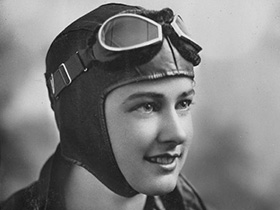You are here

11/21/1909 - 1/07/1947
Born in McKeesport, Pennsylvania, on November 21, 1909, Helen Richey was a famous female aviator. During her career as a stunt pilot, she set several records and flew with other famous female aviators like Amelia Earhart. Richey worked as a commercial pilot and volunteered to serve with the Women’s Airforce Service Pilots (WASP) during World War II. Despite her record-setting career, Richey privately struggled with depression after returning home and died of a fatal overdose on January 7, 1947.
Helen Richey was born on November 14, 1909, in McKeesport, Pennsylvania, where her father served as a school superintendent. She was educated in McKeesport and found herself drawn to technical and mechanical workings at a young age. Young Richey allegedly would stop to listen to airplanes as they flew over her head.
Richey’s love of flight was solidified in 1928 when she took a trip as a passenger on famous female aviator Ruth Elder’s airplane from Richey’s hometown to Cleveland, Ohio. She was inspired by the sight of another female pilot and decided not long after that to begin taking classes to learn how to fly. By late 1929, Richey was taking pilot classes. She made her first solo flight less than a year later, in June 1930. Richey continued to speed through her pilot’s education and became licensed to fly commercial planes in a limited manner.
During an air meet in McKeesport, Richey flew a Curtiss Fledgling training airplane and performed several stunt loops and a tailspin while in mid-air. She wanted to prove to the crowd that flying was easy enough for a 20-year-old girl to do it. After a stunning mid-air performance, Richey was offered a job as a stunt pilot. She made several other stops in her hometown throughout her career, including one to simply get a cup of coffee and something to eat because Pittsburgh was a “swell” place (Krivyanski 49).
In 1933, Frances Marsalis, another female aviator, offered Richey the opportunity to attempt an endurance flying record with her. Richey and Marsalis took off from Miami, Florida, and stayed in flight for nine days and twenty-two hours. During the flight, they endured harsh weather conditions and ripped fabric in the fuselage, which Richey is said to have repaired mid-flight. After this record-breaking effort, she continued to challenge herself and won monetary prizes and awards for her aviation skills. After gaining national attention, Richey was offered employment with Central Airlines, making her the first female pilot to fly a commercial plane to deliver mail. On December 31, 1934, Richey completed her first commercial flight. Her time with Central Airlines was short-lived as she resigned from the position after seven months. Richey then began working for the federal government as an air marking pilot where she assisted in painting town names on top of buildings to assist in guiding fellow pilots.
Richey continued breaking records even after working commercially because she enjoyed it so much. In 1936, she set two world records in aviation. She flew a Class C light plane at a speed of seventy-seven miles per hour, a feat that had not been completed at the time. She also set a record for highest altitude for planes less than 440 pounds, flying at 18,000 feet. Richey even had the chance to fly with Amelia Earhart in the 1936 Bendix race, where she put herself at risk by reaching outside of the plane to shut a door that had been forced open by strong winds during a storm so that she could complete the flight.
Richey paved the way for future female pilots in 1940 when she became the first woman to earn her pilot instructor’s license. She trained pilots when she joined the Women’s Airforce Service Pilots (WASP) in 1942. She also assisted in World War II efforts by ferrying airplanes and had the opportunity to train military pilots. After the end of the war, Richey returned to her hometown of McKeesport.
After World War II, Richey began to struggle with depression. The military and many aviation companies preferred to hire returning soldiers rather than women, and she felt that her career in flying was over due to few employment opportunities. Richey moved to New York to seek opportunities within her skill set but found none. She died from a fatal overdose in New York City on January 7, 1947. In October 2001, the Pennsylvania Historical and Museum Commission placed a historical marker in McKeesport to commemorate Richey and her many achievements in the field of aviation.
- “A Ladybird Returns Home.” Pittsburgh Post-Gazette, 2 Apr. 1943, p. 15. ProQuest, https://www.proquest.com/historical-newspapers/april-2-1943-page-15-28/docview/1854337461.
- Hauser, Robert. “Helen Richey: Record-Breaking Aviation Pioneer.” McKeesport Regional History and Heritage Center, 15 Mar. 2022, https://www.mckeesportheritage.org/helen-richey.
- "Helen Richey Begins Job as Pilot of Big Airliner.” Pittsburgh Post-Gazette, 1 Jan. 1935, p.23. ProQuest, https://www.proquest.com/historical-newspapers/january-1-1935-page-23-44/docview/1854115771.
- "Historical Marker to Honor Aviatrix.” Pittsburgh Post-Gazette, 31 Oct.2001, p 102. ProQuest, https://www.proquest.com/historical-newspapers/october-31-2001-page-102-146/docview/1871660100.
- Krivyanski, Michael J. “Helen Richey: The Sky’s the Limit!: J. Michael Krivyanski Looks at One of Aviation’s Female Pioneers.” History Magazine, vol. 11, no. 4, Apr. 2010, pgs. 48–50. EBSCO, https://search.ebscohost.com.
- Landdeck, Katherine Sharp. The Women with Silver Wings: The Inspiring Story of the Women Airforce Service Pilots of World War II. New York, Crown, 2020.
- Lynch, Adam. “Hometown Hero: Record-Setting Pilot Helen Richey Fought for a Spot in a Man’s World.” Aviation History, 1 Mar. 2012. EBSCO, https://search.ebscohost.com.
